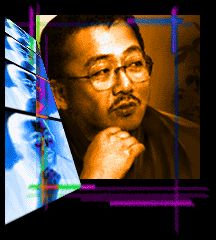


  |

Born in 1954, Katsuhiro Otomo made his comics debut 1973. His unique world outlook, a mixture of daily life and dreams, made him one of the leading artists of the "New Wave Comics Movement" and drew acclaim from all sides. In 1980, Otomo started a serial comic Young Dreams that was considered a breakthrough in comics' expression, profoundly affecting all subsequent publications. Young Dreams eventually won the Japan Science Fiction Prize; a prize formerly awarded only Science Fiction literary works.
In 1982, Otomo began work on Akira for Young Magazine. His talents were once again called upon to direct the film version in 1988. Akira hit theaters throughout Asia, North America and Europe with such raw energy and unanticipated creativity that Otomo was propelled into the limelight of international cinema.
Otomo's animated omnibus Memories followed Akira, drawing attention to some of Japan's best animation directors. In one segment of this film, called "The City of the Cannon", Otomo experimentally used only one cut per scene throughout the segment; this had never been done before. The technique was great a success, and with his exceptional perspective and vivid visual expressions, Katsuhiro Otomo had again proven his leadership in the animation community.
Interview
Q: How did you start your involvement with this film?First, Kawasaki told me about this project. Even though I didn't know the original story, once I started reading it, I found it fascinating. I thought the theme of an ancient civilization could be visually very interesting, and I liked his wide concept of the world too. Kawasaki is very good at handling an action film, so I said, " It's good material!"
Q: What kind of film do you think it turned out to be?
I think it became a large-scale film, which has a lot of fast paced action too. We had a team of very talented artists, and the music staff was excellent too. Overall, I think we made a very good film.
Q: I heard you worked a lot on script.
Yes, we did. Kawasaki and I had a lot of discussion about what we needed to add to the original story to make the film. We were satisfied with our final script.
Q: What do you think of Kawasaki as a director?
He always wanted to direct and also loves American movies. He wanted to make American-style entertainment. I think he did what he wanted to do in Spriggan. I don't know what he wants to do next. I just hope he will keep widening the horizons of animated action films.
Q: You also designed the Ark for the film.
Yes, I did. When Kawasaki asked me to do so, I came up with several designs including very classical ones and ancient-looking ones. He eventually picked a kind of strange one. I think he wanted a very unique ark instead of an old fashioned one. Something we've never seen is usually strange, and being strange is interesting.
Q: What about the poster for the film?
Since I designed the first poster for this film, I tried to emphasize the atmosphere of the film rather than the actual story. That gave the poster a dark characteristic, because the film is not merely a hero story.
Q: I felt a decadent atmosphere in the film.
I don't think the authors had such an intention. When I created Akira, even though I was not aware of that decadent atmosphere, it was reflected in that era's color. In Spriggan, there are floodwaters and storms and those elements reflect our feeling towards the end of the century. It means that this film represents our era very well.
Q: What is the position of this film in the animation community?
Animation is changing all the time. Pictures and directing methods are steadily evolving. Spriggan is at the cutting edge of that evolution. I hope many people will get to see it.
